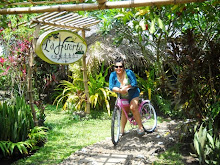business mirror, life/lifestyle section
12 may 2015
 |
| bidibidi's "fragility has its own intensity" |
 |
| bidibidi's "leafless, listless" |
in photo: bidibidi's fragility has its own intesity and her forests,
which are arresting in their solace and shadow.
bidibidi has a garden, which she calls La Huerta. bidibidi has paintings and they are all about the blooms and colors in her garden.
La Huerta, the spanish term for "vegetable garden," is more than that. it is a pocket forest along the highway going to a place called Baao in Camarines Sur, Bicol. the place is an artist's haven, a refuge if you want to dramatize how artists - visual artists in particular - in this country do not have a room or a studio of their own.
every now and then, bidibidi would hold intimate parties to welcome guests from nearby cities or towns. sometimes, i get this sense that the celebration is for no reason at all. the celebration is the reason for the celebration. in these gatherings, blooms are on the tables. it is not rare that the lowly quotidian fruit, the macopa, is presented. the sense of color then becomes remarkable as the guests appraise the tenderest of pastel on the skin of the fruit.
 |
| bidibidi's "the forest is a woman" |
 |
| bidibidi's " paths cross" |
that tenderness, such fragility, the ephemera of leaves and flowers are in this collection of paintings of bidibidi.
one such work bears the title "fragility has its own intensity." in her garden, flowers are of consequence; they are not the helpless decor that we think always of them to be. even as the artist shades the lilac and the ochre and the red, the petals are stubborn shapes suffusing the frame. behind them is a backdrop of faint yellow and light green, but they do not matter for the flowers have conquered the space.
in "dawn awaits." we encounter the profusion of blooms again, but they seem to give way to a brightening of the horizon. still strong, the flowers stand to the side.
 |
| bidibidi's "dawan awaits" |
a piece called "too much one, too much each other," bidibidi manipulates the practice of a diptych without resorting to two panels. a yellow green backdrop on the left, one notices, is slightly narrower than the blue backdrop on the right. the flowers are separated also with six forming a bouquet on the blue side and two on the left. the humor is not lost on the tradition of giving flowers, where less is more but where more is really also more given a different occasion.
 |
| bidibidi's " too much one, too much each other" |
however, i particularly covet the trees of the artist. where bidibidi's flowers are strong and vitally organic in shapes, her trees are arresting in their solace and shadow. textured and zoetic even without the foliage, the trees of bidibidi are the full narrative of our ecology.
in bidibidi's woodland, the trees form a cluster of a small forest but each trunk stands singular because of their form and their color. in a grouping of mauve trees surrounded by blue and dark green trunks and twigs, a yellow gnarled trunk twists and rises from the ground that carries the same pale yellow color. then you realize: it is the sun filtering and singling out a tree.
in another pairing of trees, six stumps - the middle gloomy red and deep green, the leftmost growth in pallid eggyoke and the rightmost towering in near black shade - are seen amid a cloud of what looks like foliage or a mass of soil. the impact of the arrangement is one of caution and concern. but the artist is not saying anything; she is making us feel something in the forest.
in another forest, bidibidi's images for us thin trees. are they dying or growing? a blue backdrop is the only heavenly item within this frame where growth and decay seemingly form two sides in the life-coin.
 |
| bidibidi's "when the river runs dry" |
the works of bidibidi, without diminishing her own authenticity, reminds me of another bicolana artist, the Italy-based Lina Llaguno-Ciani. where Ciani's works are marked by distinct minimalism (her works have been described as "surrealism without angst"), bidibidi's trees and flowers subjugate a palette of colors. bidibidi is a neo-Fauvist, in love with all kinds of colors and shades.
i have always wanted to write about this artist mainly because i admire her concern for new artists. i have seen her La Huerta, the empirical garden in her farm.
her service to art, however, is in her ability to color the growth in forests that are either vanishing or becoming, and to pay tribute to the vain and valiant flora in her mind.




No comments:
Post a Comment